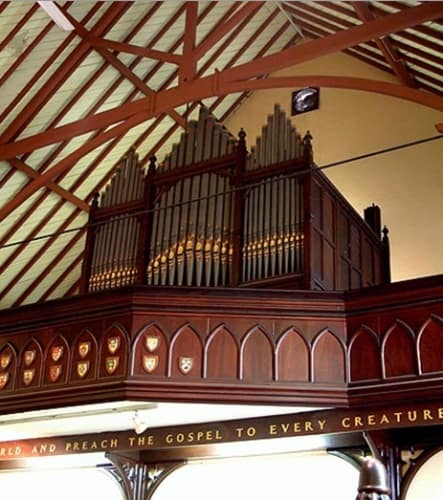One of the treasures of Sydney Town Hall is the Grand Organ. The ‘finest instrument ever built by an English organ builder’ has a Glebe connection.
William Wood arrived in Sydney from London in 1890 to supervise the voicing and tuning of Sydney Town Hall’s newly acquired Grand Organ, reputed to be the largest in the world with one pipe nearly 20 metres long, and was contracted to remain in Sydney as its first regular tuner. At the time of his death he was living at 41 Westmoreland St Glebe and had an organ factory in Shepherd St Chippendale.

The son of an organ builder, Wood was born in Ledbury, Herefordshire. In 1886 he was one of a team of 30 in the London workshop of William Hill & Son when news came that the firm had won the contract to build the Sydney organ. Before being dismantled and shipped out in 94 crates in 1889, the instrument was put on display and played before an audience of Australian dignitaries by William Thomas Best, the celebrity organist who was to give the inaugural recital in its new home. Best landed in Sydney in April 1890, five months after construction had begun, to find only a few pipes in position. By June he was talking about going back home, the Evening News describing as a ‘disgrace’ his fee and expenses plus the £15,000 price tag on the organ itself. The long-awaited concert finally took place in August. The organ’s power was demonstrated to the audience of 4000 – whose tickets paid Best’s fee – when its loudest peals caused ‘snowflakes’ to fall from the Town Hall ceiling. William Wood then travelled to Goulburn to work on another newly landed Hill & Son organ in preparation for its inauguration by Best in the town’s Roman Catholic Cathedral in September 1890.
Wood continued to modify the Sydney Town Hall organ, improving its sound and making it lighter to play. He established a good relationship with the first City Organist, Auguste Wiegand, who got work for him renovating and enlarging other instruments. Commissioned to give the opening recital of the organ in St Benedict’s Catholic Church on Broadway, Wiegand arranged for Wood to make the necessary additions and modifications. Wood also renovated the original organ in Sydney’s St Patrick’s Catholic Church (the pipes arrived on the day of Wiegand’s reopening recital, so Wood was still fixing it after the audience had begun taking their seats) and in 1895 he erected its replacement.
William Wood died of tuberculosis on 2 May 1897, survived by his widow, Gloucester-born Sarah née Jennings, who died aged 87 on 26 May 1926. Their eldest child, Charles William Wood, born in 1865, succeeded his father as tuner of the Town Hall organ and worked on others including those in St Barnabas’ Broadway and Sydney University’s Great Hall. In 1901-2 Charlie was in brief partnership with Tom Matanle; Matanle & Wood built the organ of Ashfield Presbyterian Church. To increase the realism of the musical ‘storms’ in Sydney Town Hall he built a rain and hail machine, its sound created by turning the handle of a two-gallon drum containing loose stones. In 1900 he secured a position with the premier colonial organ builder George Fincham & Son but then changed his mind, an action which would have damaged his reputation, especially as the firm had already sent out 350 letters to churches advising of his appointment. He seems to have been similarly cavalier in his attitude to his Town Hall duties. Ratepayers began complaining of the £500 annual cost of maintaining and playing the instrument, and Wiegand’s successor Arthur Mason became increasingly dissatisfied with the standard of Wood’s work. After visiting English organist Edwin Lemare pronounced the organ out of tune and the gas engine for pumping the bellows unreliable, Wood’s contract was not renewed on the grounds of ‘inefficiency’. He resigned in 1903.
In 1906 Charles, recording his marital status as ‘widower’ from Birmingham, married Maude Isobel Phillips; the couple had four children. He served with the AIF in the First World War. Occupation piano tuner, he died at Lidcombe Hospital on 19 January 1943; Maude died aged 73 in the Mental Hospital, Auburn, on 3 August 1958. She had been refused a war service pension as it turned out her husband was a bigamist. When he settled in Australia he left behind a wife and two children in England.
Sources: Ampt, Robert The Sydney Town Hall Organ ca 1999; Australian War Memorial service records; City of Sydney Archives; Daily Telegraph 1 December 1895; Evening News 10 June 1890, 15 July 1903, 17 July 1903; Freeman’s Journal 4 January 1890, 19 April 1890, 13 August 1892; Illustrated Sydney News 16 August 1890; The Largest Organ in The World and the Musical Artists of Sydney 1892; NSW births, deaths, marriages registry; NSW cemetery records; Rushworth, Graeme D Historic Organs of NSW 1988; Rushworth, Graeme D A Supplement to Historic Organs of NSW 2006; Sands’ Directories; Sydney Morning Herald 8 August 1892, 22 October 1892, 3 May 1897; Sydney Town Hall website.








One comment. Please add yours.
This was my great grandfather.